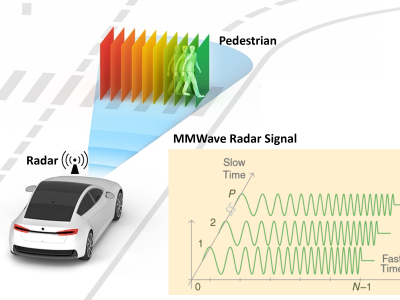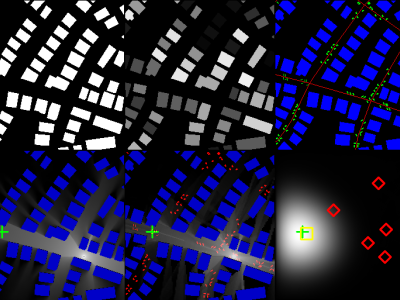CRAWDAD intel/home

- Citation Author(s):
-
Konstantina Papagiannaki (Telefonica I+D)Mark Yarvis (Intel Research)W. Steven Conner (Intel Corporation)
- Submitted by:
- CRAWDAD Team
- Last updated:
- DOI:
- 10.15783/C7V886
- Data Format:
 137 views
137 views
- Categories:
Abstract
Connectivity and throughput measurement from home wireless networks.
Measurements reflect connectivity and UDP/TCP throughput data collected from a grid of six nodes placed within three different houses.
date/time of measurement start: 2005-06-29
date/time of measurement end: 2005-07-03
collection environment: Measurements reflect connectivity and UDP/TCP throughput data collected from a grid of six nodes placed within three different houses, 2 in the United States (denoted ushome1 and ushome2) and 1 in the United Kingdom
(denoted ukhome1). Results have been collected for different values for transmission power and transmission rate, as well as 802.11a and 802.11b wireless devices.
A brief description of the three houses along with approximate floorplans (which can be downloaded from the trace intel/home/reachability/floorplan) are shown below.
Label Size (ft^2) Construction Floors Nodes
-------------------------------------------------------
ushome1 2,500 Wood 2 6
ushome2 2,600 Wood 3 6
ukhome1 1,500 Brick/steel 3 6
network configuration: For 802.11b experiments the nodes are small form-factor PCs with Netgear MA701 compact flash 802.11b wireless cards. The nodes run Linux kernel version 2.4.19 and the hostap driver. For 802.11a experiments the nodes are laptops with NetGear WAG511 CardBus 802.11a/b/g cards running Linux kernel version 2.4.26 and the MIT madwifi-stripped driver. All radios have omnidirectional antennas, and could be considered comparable to the radios that are likely to be integrated in future consumer electronics, e.g. cheap radios with basic functionality. Lastly, all three testbeds are homogeneous; each node consists of the exact same hardware to limit the impact of hardware peculiarities on the obtained results.
Our network setup is common among all experiments. All nodes utilize an unused frequency that is at least five channels away from the next occupied 802.11 frequency. To facilitate our experiments, we utilize the 802.11 Independent Basic Service Set (IBSS) mode, which allows all nodes to communicate directly. However, this configuration does not constrain the usefulness of our results to ad hoc (mesh) topologies.
data collection methodology: Each node is instructed to run an experiment toward every other node in turn. Our experiments are designed to assess: (i) success/loss rate, and (ii) throughput under different combinations of txrate and txpower. We further alter the node location for specific experiments in order to quantify the impact of exact node location, antenna orientation, and obstacles. Experiments are carried out during the night to avoid interference from moving people and facilitate reproducibility. Except where explicitly stated, each result represents a single experimental run, due to the highly time consuming nature of our experiments. Instead, we rely on the validating runs presented in the following subsections to lend credence to our results.
Traceset
intel/home/reachability
Reachability and throughput measurement from home wireless networks.
- measurement purpose: Network Performance Analysis
- methodology: Reachability: The reachability experiments assess link quality between each pair of nodes in the home network in terms of success/loss rate, and rely on a series of UDP probe packets sent from every node to every other node. Each probe packet lists the source node, as well as its number in the series. The size of the probe packet and the duration of each sub-experiment are configurable. In all experiments, link-layer retransmissions were disabled, the probe size was 1472 bytes, and the duration of each sub-experiment was 60 seconds, with a frequency of one packet every 500 ms. Each individual wireless link is assessed independently, and no simultaneous transmissions take place inside the network.
Throughput: The throughput experiments were run to assess the quality of layer-3 communication within the home network. Throughput was assessed for both TCP and UDP protocols. For our throughput experiments we use the same basic methodology which relies on measurements from all pairings of the six nodes in the testbed. Throughput is measured by the netperf traffic generator using 1472 byte packets. Each node initiates a netperf connection to every other node (in turn) and measures the throughput achieved over a 60 second time interval. Unlike the reachability experiments, the throughput experiments are conducted with link layer retransmission enabled (maximum of 3 retries), which is likely to alleviate the effect of short term degradation in link quality.
Autorate: UDP/TCP throughput measurements are collected for 60 second flows when transmitters employ autorate.
intel/home/reachability Traces
- floorplan: Approximate floorplan for the three houses.
- file: floorplan.tar.gz
- configuration: Floorplan for three different houses, 2 in the United States (denoted ushome1 and ushome2) and 1 in the United Kingdom (denoted ukhome1). The lines in the floorplan images reflect the (unidirectional) links that exhibited more than 90% loss in the reachability experiments.
- format: three png image files
- distance: Distance between each pair of nodes.
- file: distance.tar.gz
- configuration: Distance between each pair of nodes in the three houses (ushome1, ushome2, and ukhome) in the original deployment in feet
- format: distance in each row
- results: Distance between each pair of nodes.
- file: reachability.tar.gz
- configuration: Reachability and Throughput Results.
- format: File names are as follows:
{House}-{Exp}-{Network}-{Traffic}-{Txrate}-{Txpower}.{Mode}.txt
- House: ushome1, ushome2, or ukhome
- Exp: original (original topology), validation (validation run),
rotated (with nodes rotaetd by 180 degrees), or
autorate (with autorate on)
- Network: b (802.11 b) or a (802.11 a)
- Traffic: udp or tcp
- Txrate: TX rate (e.g., 2Mbps)
- Txpower: TX power (e.g., 30mW)
- Mode: comb (for reachability/throughput experiments),
or top (for multihop throughput experiments)
All files are of the following format.
Each row corresponds to the measurements collected from node2->node3,
node2->node4, node2->node5, node2->node6, node2->node7, node3->node2,
node3->node4, etc. (node1 was used to control the experiments).
The first column of measurements corresponds to the number of UDP probes
that were successfully received (total number of probes is 120).
The second column captures the throughput measured from the source node
to the destination node in Mbps.
intel/home/multihop
Multihop throughput measurement from home wireless networks.
- measurement purpose: Network Performance Analysis
- methodology: Multihop: For one specific node in the testbed we setup multihop paths through every other node in the testbed and measure the resulting UDP throughput using netperf. We establish that the resulting multi-hop UDP throughput can be well approximated by
thr(src, dst) = 1/(1/thr(src,relay)+1/thr(relay,dst)),
where src denotes the transmitting node, dst denotes the receiving node,
and relay denotes the node that relays traffic between the two.
Using this formula we compare the performance of the network under
three different topologies
(i) Direct where each node communicates with every other node using
the direct path,
(ii) AP-topology, where one specific node is selected to act as a relay
between any two other nodes in the testbed, and
(iii) Multihop-topology, where nodes communicate with each other either
using the optimal path through the topology, where optimality captures
minimum airtime. In this last case, we assume that paths are selected
using Dijkstra's algorithm and link weights relay airtime, i.e. a path
is selected such that a packet between the two nodes occupies the least
amount of time in the network.
All experiments test performance for a single flow between two nodes
in the testbed. There are no contending transmission occupying the network.
intel/home/multihop Trace
- results: Multihop UDP Throughput Results.
- file: multihop.tar.gz
- configuration: To assess the accuracy of approximating 2-hop throughput using single hop measurements, we used node2 in ukhome1 as a transmitter and measured 2-hop throughput to every other node in the home using every other node as a relay. We then compared our estimate against the measured 2-hop value. Notice that this kind of analysis looks into UDP throughput alone.
- format: File names are as follows:
{House}-{Exp}-{Network}-{Traffic}-{Txrate}-{Txpower}.{Mode}.txt
- House: ushome1, ushome2, or ukhome
- Exp: original (original topology), validation (validation run),
rotated (with nodes rotaetd by 180 degrees), or
autorate (with autorate on)
- Network: b (802.11 b) or a (802.11 a)
- Traffic: udp or tcp
- Txrate: TX rate (e.g., 2Mbps)
- Txpower: TX power (e.g., 30mW)
- Mode: comb (for reachability/throughput experiments),
or top (for multihop throughput experiments)
All files are of the following format.
The first row denotes the pairs of nodes tested and
each other row has an experiment descriptor that indicates
the type of topology tested.
Instructions:
The files in this directory are a CRAWDAD dataset hosted by IEEE DataPort.
About CRAWDAD: the Community Resource for Archiving Wireless Data At Dartmouth is a data resource for the research community interested in wireless networks and mobile computing.
CRAWDAD was founded at Dartmouth College in 2004, led by Tristan Henderson, David Kotz, and Chris McDonald. CRAWDAD datasets are hosted by IEEE DataPort as of November 2022.
Note: Please use the Data in an ethical and responsible way with the aim of doing no harm to any person or entity for the benefit of society at large. Please respect the privacy of any human subjects whose wireless-network activity is captured by the Data and comply with all applicable laws, including without limitation such applicable laws pertaining to the protection of personal information, security of data, and data breaches. Please do not apply, adapt or develop algorithms for the extraction of the true identity of users and other information of a personal nature, which might constitute personally identifiable information or protected health information under any such applicable laws. Do not publish or otherwise disclose to any other person or entity any information that constitutes personally identifiable information or protected health information under any such applicable laws derived from the Data through manual or automated techniques.
Please acknowledge the source of the Data in any publications or presentations reporting use of this Data.
Citation:
Konstantina Papagiannaki, Mark Yarvis, W. Steven Conner, intel/home, https://doi.org/10.15783/C7V886 , Date: 20060416
















